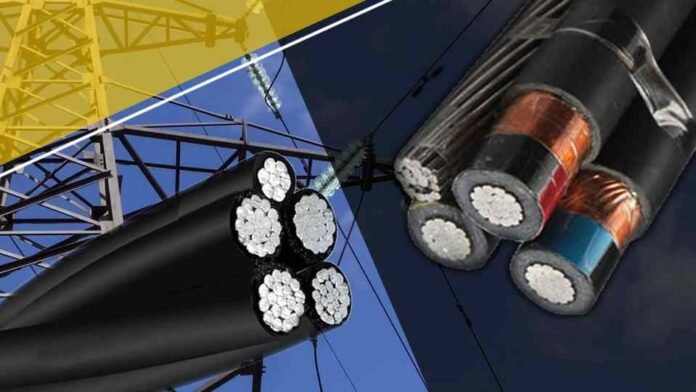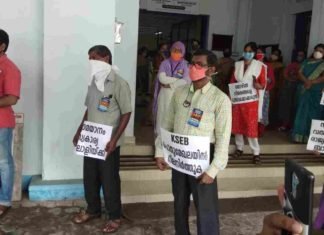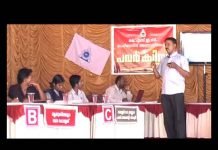For transmitting electricity to consumers, utilities use overhead and underground cables. Conventionally, bare overhead conductors are used since they are the cheapest and easiest to build. They utilise air as natural insulation and there is no need for additional insulation, and have specially designed isolators present only on line supports. When installed using efficient fitting techniques, these conductors help in achieving a relatively low cost of construction of the overhead electricity network. However, they are difficult to erect in complex network areas and are not safe, especially in densely populated areas.
On the other hand, underground cables offer a safer alternative. Their other advantages include lower maintenance costs and lower risks from harsh weather conditions as compared to overhead cables. However, underground cables are costlier to build than overhead systems as the ground needs to be excavated. This can be difficult when passing through geographic obstructions such as hills, marshes and rivers. Special trenches need to be constructed when passing through loose soil. Besides, heat dissipation in underground cables is an issue. Therefore, the conductors need to be thicker and require expensive insulation.
Aerial Bunched Cable (also aerial bundled conductors or simply ABC) is an innovative concept for Over Head (OH) power distribution. Aerial bundled cables are overhead power lines using several insulated phase conductors bundled tightly together, usually with a bare or Insulated neutral conductor. This contrasts with the traditional practice of using uninsulated conductors separated by air gaps.
When compared to conventional bare conductor OH distribution systems, ABC provides higher safety and reliability, lower power losses, stability in voltage regulation and ultimate system economy by reducing installation, maintenance and operation costs. This system is ideal for rural distribution as well as in congested urban areas . In Rural area, it is very attractive for installation in difficult terrain such as hilly areas, dense forests, coastal regions, etc. These lines can also be laid without cutting or trimming any trees. In Urban area ABC is considered to be the best choice for Power Distribution in congested areas with narrow lanes and by-lanes. Due to its insulation, it is convenient to lay even in densely populated areas with narrow gaps between buildings, where it is usually not possible to run bare conductors. Additionally, accidental electrocutions are avoided by the insulation of the cable. Since the cables are clearly visible, the faults can be detected and rectified quickly and with ease. Damage due to water logging is also avoided as compared to underground cables. ABCs are highly reliable and the insulation has been developed to withstand heat, cold and intense sunlight. The insulation reduces the number of short circuits, over-voltages and transformer burnouts caused by thunderstorms. Fewer hardware accessories are needed as each one can be used with many different sizes of cable. Since the cable can also be supplied with conductors for street lighting, it is more cost-effective.
Classification of ABC:-
As per the constructional features of Voltages to which it is to be used ,ABCs are classified LT ABC and HT ABC.
The Standard applied for the use of ABC:-
IS 14255-Aerial Bunched Cables for working Voltages up to and including 1100 Volts.
REC Specification-Aerial Bunched Cables for LT Lines.
REC Specification-Aerial Bunched Cables for 11kV Lines.
Hardware Accessories for Drawing ABCs:-
The following common and specially designed accessories are required for drawing LT and HT ABCs on Electric poles.
1. Suspension Clamp assembly.
2. Dead End (Anchor) Clamp assembly.
3. Stainless Steel Strap.
4. Stainless steel Buckle.
5. UV Plastic Ties.
The standards to be adopted for the selection, testing and installation of these items are NF C 33 040 -1998, NF C 33-041 -1998.The Technical Specification of these accessories will vary depending upon the Voltage and size of cables used.
For LT ABCs, the following accessories additional- exclusive are required
- Insulation Piercing connector (Commonly known as IPCs).
- Multi Port Insulation Piercing Connector (Also Known as Multi port Insulation Piercing Satellite Connector).
- End Ternination Kits .
- Pole Top Multi port Distribution Box.
The standards to be adopted for the selection ,testing and installation of these items are NF C 33 021-1998, NF C 33-004-1998, NFC 33 020-1998.The Technical Specification of these accessories will vary depending upon the Voltage and size of cables used.
For HT ABCs ,the following accessories are additionally required - Medium Voltage Connector (Commonly Known as MVTs)
- End Ternination Kits .
The Technical Specification of these accessories also will vary depending upon the Voltage and size of cables used.
Construction of LT ABC:-
LT ABC shall consists of Conductor and Insulation as per standards. - Conductor:-
The Conductor can be Phase/Street light and Neutral.Phase/Street Light Conductor Shall be made of H2 or H4 grade Aluminium complying with the requirements of IS 8130:1984. The power/outer insulated neutral/street lighting conductors shall
confirm to flexibility class 2 of IS 8130 : 1984. The Size os street light Conductor shall be 16 Sq.mm.
The Messenger/Neutral Conductor shall be made of heat treated Aluminium-magnesium ( 0.5%)-silicon( 0.5%) alloy wires. The messenger (Neutral conductor) or otherwise shall be either stranded circular or compacted circular type and shall have minimum 7 strands. The surface of the conductor shall be smooth. A protective barrier may be applied between the conductor and insulation, if required. Such barrier, when used, shall be compatible with insulating material and suitable for the operating temperature of the cable.
The size of Messenger conductor and its breaking load shall be as per the table below:
- Insulation:-
The insulation shall be either of cross-linked Poly ethylene or Poly ethylene confirming to standards and requirements as per IS 14255. The conductor (with protective barrier, wherever applied) shall be provided with crosslinked polyethylene or polyethylene insulation applied by extrusion. The average thickness of insulation shall be not less than the following nominal value:
Core Identification:-
The phase conductors shall be provided with one, two or three ‘ridges’ for quick identification. The street lighting Conductor and messenger conductor (if insulated) shall not have any identification mark.
ASSEMBLY (LAYING UP):
Three insulated phase couductors, and a street lighting conductor (if required) shall be twisted around the insulated messenger conductor without fillers with a lay not exceeding 3.5 times the diameter of the insulated phase conductor.
Different sizes of LT ABCs:-
As per the requirement based on the load, the different sizes of LT ABCs are available as below:-
- Aerial Bunched Cable LT 3×95 + 1×16 + 1×70 sq.mm (Insulated Messenger)
- Aerial Bunched Cable LT 3×70 + 1×16 + 1×50 sq.mm (Insulated Messenger)-Commonly used
- Aerial Bunched Cable LT 3×50 + 1×16 + 1×35 sq.mm (Insulated Messenger)
- Aerial Bunched Cable LT 3×35 + 1×16 + 1×25 sq.mm (Insulated Messenger).
- Aerial Bunched Cable LT 3×70 + 1×50 sq.mm (Insulated Messenger)
- Aerial Bunched Cable LT 3×50 + 1×35 sq.mm (Insulated Messenger)
- Aerial Bunched Cable LT 1x 25 + 1×25 sq.mm (Insulated Messenger)-For LT Single phase service connection.
Construction of HT ABC:-
HT ABCs shall consists of the following sections:
Conductor, Conductor Screen, Conductor insulation, Conductor insulation screen, Conductor insulation metallic screen and Conductor outer sheath.
Conductor:
The 3 Core phase cable conductors shall be of round stranded and compacted aluminum wires of nominal cross sectional area 25sq. mm to 150 mm and complying with the requirements of IS: 8130/1984.
CONDUCTOR SCREEN:
This Shall be Extruded semi-conducting cross-linked polyethylene compound as per IS-7008 (Part-2), 1985. Conductor screening shall be non-metallic and shall consist of either semi-conducting compound or a layer of extruded semi-conducting linked polyethylene compound of thickness not less than 0.5 mm.
CONDUCTOR INSULATION: Extruded cross-linked polyethylene as per IS:7098 (part–2)1985–nominalinsulationthickness3.6mm.
CONDUCTOR INSULATION SCREEN:
This shall be of Extruded semi-conducting cross linked polyethylene compound and semi conducting crepe paper/tape to IS:7098 (Part-II-1985).
CONDCUTOR INSULATION METALLIC SCREEN:
Ths is Longitudinal Aluminium tape bonded with melt glue to sheath to IS: 7098 (Part-2) 1985.
CONDUCTOR OUTER SHEATH:
This shall be of Extruded black polyethylene compound type ST 3 to IEC 502 for 3 Core ABC. Over the armouring, the cable shall be provided with extruded PVC outer sheath. The composition of the PVC compound for outer sheath shall be Pre-Type ST2 of IS-583 – 1984. The colour of the outer sheath shall be black. The average thickness of the sheath shall not be less than the standard values specified in the IS when measured as laid in IS-7098 (part-II)/1985.
Messenger:
The insulated messenger Stranded and compacted All Aluminium Alloy (AAA) conductor conforming to I.S.7098 (Part-II) 1985 to serve the purpose of neutral in the network and also to carry the weight of the entire AB Cable under suspension on overhead lines.
Messenger wire shall be of 35 / 50 / 70 /95/150/240 sqmm (nominal area) and shall be PVC insulated to avoid damage to the outer insulating sheath of single core phase cable twisted around the messenger. There shall be no joints in any wire of the stranded messenger conductor except those made in the base rod or wires before finally drawing.
MESSENGER INSULATION :
This shall be of Extruded weather resistant black cross – linked polyethylene. Rated Voltage 1.1 kV, insulation thickness 1.4 mm minimum.
Different sizes of HT ABCs:-
HT ABCs are selected and normally to be used based on the maximum Short circuit current withstanding capacity and normal current carrying capacity as detailed below:
























